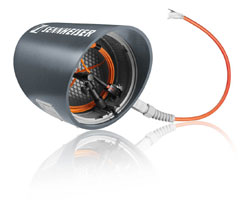

Sennheiser Mics Hear the Light
Sennheiser recently launched the MO 2000 optical microphone with a new type of transducer that processes acoustic signals on the basis of variations in light intensity. The new type of engineering makes the MO 2000 well suited for applications where other microphones are only partly suitable or are completely unusable.
Sennheiser recently launched the MO 2000 optical microphone with a new type of transducer that processes acoustic signals on the basis of variations in light intensity, according to the company. The new type of engineering makes the MO 2000 well suited for applications where other microphones are only partly suitable or are completely unusable. Sennheiser also introduced the IAS MO 2000 SET, the company’s first microphone certified by EMI/EMC laboratories for use in potentially explosive atmospheres.
“By implementing the optical principle, both the microphone head and the electronics can be located far away from each other,” said David McNutt, industry team manager for installed sound, in a statement. “And to insure functionality in demanding environments, the microphone head is completely constructed of a plastic material that can withstand exposure to aggressive substances such as gases, salts, and humidity. No electric current flows through the microphone head. All these features make this optical microphone the perfect candidate for applications in which communication or measurements are required under the most difficult conditions.”
In the medical field, the company said, the optical microphone can be used in magnetic resonance imaging (MRI) in order to maintain contact with the patient during MRI scans or to provide active noise cancellation. Because it has a metal-free and current-free design, the microphone head doesn’t interfere with the imaging process, nor do the magnetic fields inside the equipment effect the microphone.
The optical mic also benefits from its metal- and current-free design when used in measuring applications. In EMI/EMC laboratories, it functions as an “artificial ear” on a mobile phone without distorting the measurements, the company says.
A special version of the optical microphone is available for use in potentially explosive atmospheres and outdoor applications. For example, the IAS MO 2000 SET can be used for acoustic monitoring of gas dehydration plants in natural gas production, says the company. In such a case, the microphone can aurally detect slow leaks that are otherwise too small to cause pressure loss or trigger an alarm in other monitoring systems.
According to the company, inside the optical microphone, light from an LED is directed onto a reflective diaphragm via fiber optic cable. The diaphragm reflects part of the light into a receiver fiber optic cable. If the diaphragm is moved by sound signals, the reflected light beam is deflected, with the result that more or less light is coupled into the receiver fiber optic cable. At the end of the receiver fiber optic cable, a photodiode converts the light intensity variations into electrical signals.
Other features of the microphone include an omni-directional polar pattern, a frequency response of 20 Hz to 40 kHz (+/-6 dB), and 134 dB maximum sound pressure.









